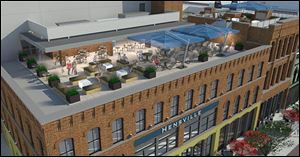
FEATURED EDITORIAL
Building on Toledo’s legacy
12/17/2015
Projects in downtown Toledo such as the Toledo Mud Hens’ Hensville entertainment district show how preservation of historic structures can encourage redevelopment and job creation. There need to be many more such efforts in the city’s core, to identify new uses and tenants for such once-magnificent, now largely neglected structures.
Toledo is a so-called legacy city — one of a group of older, industrial urban areas that are mostly in the Midwest and Northeast, and disproportionately in Ohio and Michigan. Our city, like other legacy cities, has endured big losses in population and jobs, aggravating such persistent problems as concentrated poverty, limited fiscal resources, reduced public services, and abandoned buildings.
But as the name implies, a legacy city such as Toledo, despite its Rust Belt tag, also has strengths that can promote recovery and economic growth: vital civic and cultural institutions, lively and diverse neighborhoods, affordable housing, available land, productive businesses, openness to immigrants. As Mayor Paula-Hicks Hudson seeks to exploit these advantages to redevelop Toledo, she also should focus on the benefits of preserving the city’s historic buildings and cultural heritage.
Click here for more Blade editorials
A new report by Rutgers University and the Preservation Rightsizing Network, which works with legacy cities on issues of historic preservation, shows how cities such as Toledo can address their economic challenges by taking new approaches to their assets. The study’s “action agenda” for historic preservation in legacy cities consists of sensible prescriptions and innovations, which communities such as Cleveland and Detroit already are putting into effect.
The agenda acknowledges that preservation advocates need to listen to people — including young people and artists — in the communities they purport to help, who may have more immediate concerns than history. They must reconcile their priorities with the resources available to them.
Preservationists must rely on sound data, not hunches; an example of the former is the Lucas County Land Bank’s survey this year of every property in Toledo. They must collaborate with public and private partners who have a broad range of interests, which may sometimes conflict.
Projects in downtown Toledo such as the Toledo Mud Hens’ Hensville entertainment district and ProMedica’s renovation of the vacant steam plant along the riverfront show how preservation of historic structures can encourage redevelopment and job creation. There need to be many more such efforts in the city’s core, to identify new uses and tenants for such once-magnificent, now largely neglected structures as the Spitzer, Nicholas, and Madison buildings.
Tax abatements and credits and other government loan and grant programs can jump-start rehabilitation and private investment in a still-struggling real estate market such as Toledo’s. But they need to be carefully targeted and monitored, not dispensed as political party favors. And they need to be fully transparent to the taxpayers who subsidize them.
In Toledo neighborhoods, institutions such as the county land bank are working not only to board up and demolish vacant buildings that can’t be rehabilitated, but also to protect and preserve those that can. Local officials must work closely with business and community leaders to promote both goals: to overcome blight and to improve the city’s housing stock.
That will require renewed efforts in such areas as preventing foreclosures, helping would-be home buyers with down payments, and strengthening code enforcement. It means investing limited resources where they can do the most good, instead of dribbling them out across the city to meet a “where’s mine?” politician’s idea of ostensible fairness.
David Mann, the Lucas County Land Bank’s president, says legacy cities such as Toledo “must seize new tools and new strategies ... to preserve all that makes them special.” The preservation agenda suggests a toolkit that Toledo officials can use to help the city not only survive but prosper, even as challenges persist. The first step is putting these tools, and Toledo’s rich history, to work.